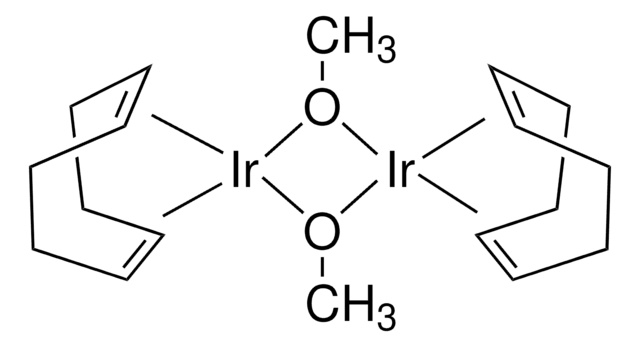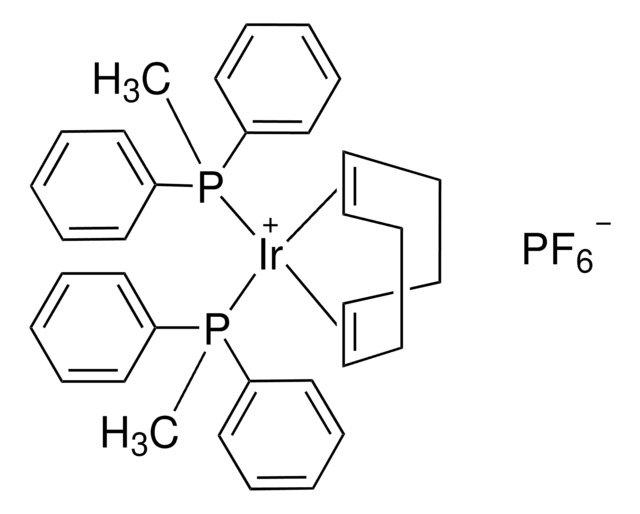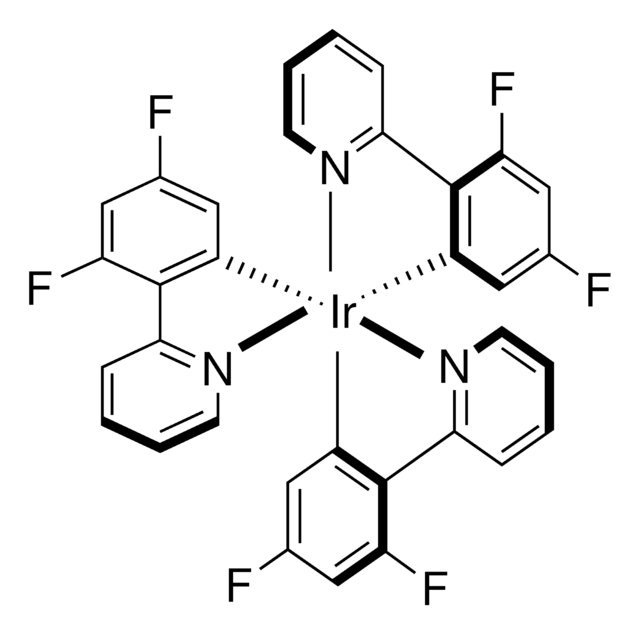29590
(1,5-Cyclooctadiene)(pyridine)(tricyclohexylphosphine)-iridium(I) hexafluorophosphate
≥99.0% (C)
Synonym(s):
[Ir(cod)(PCy3)(py)]PF6, (1,5-Cyclooctadiene)(pyridine)(tricyclohexylphosphine)-Ir(I) PF6, Crabtree’s catalyst, Iridium(I) hexafluorophosphate (1,5-Cyclooctadiene)-(pyridine)-(tricyclohexylphosphine) complex, [Ir(cod)(PCy3)(py)]PF6
About This Item
Recommended Products
Assay
≥99.0% (C)
reaction suitability
core: iridium
reagent type: catalyst
mp
175 °C (dec.) (lit.)
SMILES string
[Ir+].c1ccncc1.F[P-](F)(F)(F)(F)F.C2CC=CCCC=C2.C3CCC(CC3)P(C4CCCCC4)C5CCCCC5
InChI
1S/C18H33P.C8H12.C5H5N.F6P.Ir/c1-4-10-16(11-5-1)19(17-12-6-2-7-13-17)18-14-8-3-9-15-18;1-2-4-6-8-7-5-3-1;1-2-4-6-5-3-1;1-7(2,3,4,5)6;/h16-18H,1-15H2;1-2,7-8H,3-6H2;1-5H;;/q;;;-1;+1/b;2-1-,8-7-;;;
InChI key
UJXHUUQZACSUOG-KJWGIZLLSA-N
Looking for similar products? Visit Product Comparison Guide
Related Categories
Packaging
Other Notes
Signal Word
Warning
Hazard Statements
Precautionary Statements
Hazard Classifications
Eye Irrit. 2 - Skin Irrit. 2 - STOT SE 3
Target Organs
Respiratory system
Storage Class Code
11 - Combustible Solids
WGK
WGK 3
Flash Point(F)
Not applicable
Flash Point(C)
Not applicable
Personal Protective Equipment
Certificates of Analysis (COA)
Search for Certificates of Analysis (COA) by entering the products Lot/Batch Number. Lot and Batch Numbers can be found on a product’s label following the words ‘Lot’ or ‘Batch’.
Already Own This Product?
Find documentation for the products that you have recently purchased in the Document Library.
Customers Also Viewed
Related Content
The Crabtree Group developed the [(cod)IrLL']PF6 series of catalysts, where L is a P-donor such as PCy3 and L' and N-donor such as pyridine. These are very active in the hydrogenation of sterically hindered alkenes. The catalyst also shows directing effects as a result of binding of the catalyst to suitable functional groups on the substrate, followed by addition of H2 from the same side of the substrate that the functional group is located. Two versions of the catalyst are available from us one with PF6 and the other with BArF4 counteranion.
Our team of scientists has experience in all areas of research including Life Science, Material Science, Chemical Synthesis, Chromatography, Analytical and many others.
Contact Technical Service

![[Ir(cod)(acac)] Umicore](/deepweb/assets/sigmaaldrich/product/structures/188/615/470bfca9-6b61-476a-9486-f7da61962e4c/640/470bfca9-6b61-476a-9486-f7da61962e4c.png)



![(Ir[dF(CF3)ppy]2(dtbpy))PF6](/deepweb/assets/sigmaaldrich/product/structures/982/913/02dd8ddd-6deb-40a0-ab9b-07b18f1abb09/640/02dd8ddd-6deb-40a0-ab9b-07b18f1abb09.png)




![1,5-Cyclooctadiene{[dibenzyl((4S,5S)-5-methyl-2-phenyl-4,5-dihydro-4-oxazolyl)methyl]dicyclohexylphosphinite κN:κP}iridium(I) tetrakis(3,5-bis(trifluoromethyl)phenyl)borate 97%](/deepweb/assets/sigmaaldrich/product/structures/139/575/e2052bbf-fcaa-4d37-a53a-3cab3894162b/640/e2052bbf-fcaa-4d37-a53a-3cab3894162b.png)
![1,5-Cyclooctadiene{[dibenzyl((4R,5R)-5-methyl-2-phenyl-4,5-dihydro-4-oxazolyl)methyl]dicyclohexylphosphinite κN:κP}iridium(I) tetrakis(3,5-bis(trifluoromethyl)phenyl)borate 97%](/deepweb/assets/sigmaaldrich/product/structures/109/838/8e9b273f-4ee4-4ff5-a3f7-cebe84a877bc/640/8e9b273f-4ee4-4ff5-a3f7-cebe84a877bc.png)
